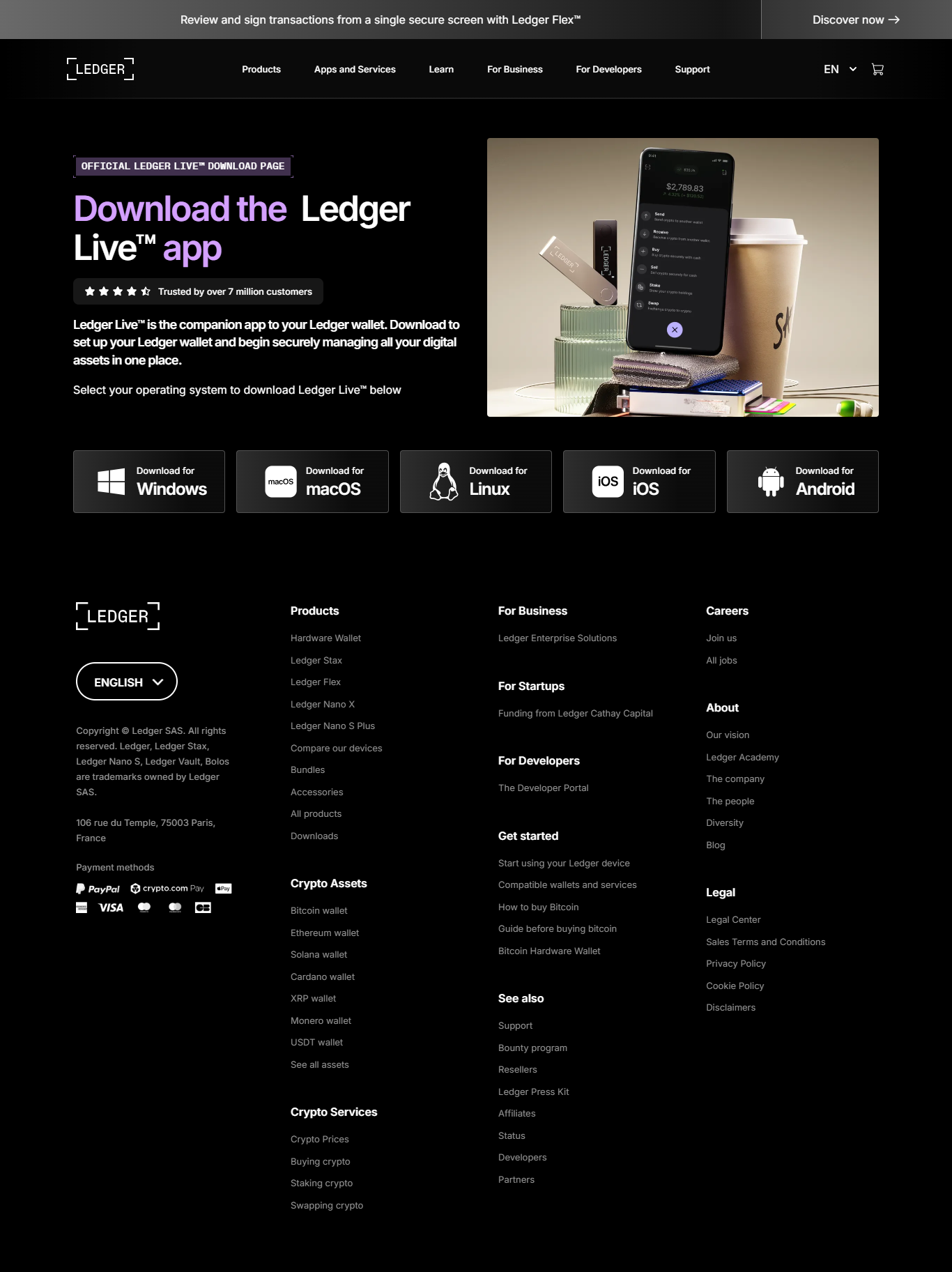What is Ledger Live Desktop?
Ledger Live Desktop is the official desktop application from Ledger that acts as the management hub for Ledger hardware wallets. Ledger Live Desktop connects to your Ledger device locally, allowing you to install blockchain apps on the device, add accounts, view balances, sign transactions, and access optional services — all while keeping private keys secured on the Ledger device.
Why choose Ledger Live Desktop for secure crypto management?
Using Ledger Live Desktop keeps sensitive signing operations isolated to the hardware device. Ledger Live Desktop is designed so that your private keys never leave the Ledger device; the desktop app only displays information and transmits unsigned transaction data for you to review. Combining Ledger Live Desktop with a well-protected hardware device dramatically reduces attack surfaces compared to custodial or software-only wallets.
Prepare: system requirements & safety checklist
Before installing Ledger Live Desktop, verify your environment and prepare your Ledger device:
- Compatible OS: Windows, macOS, or Linux (check Ledger's official requirements before downloading).
- Use a trusted computer — avoid public or unmanaged devices for sensitive actions involving Ledger Live Desktop.
- Keep your 24-word recovery phrase written and stored offline; never type it into Ledger Live Desktop or any computer.
- Have your Ledger hardware device (Ledger Nano S Plus, Ledger Nano X, etc.) and original cable ready.
Confirm you are downloading Ledger Live Desktop from the official Ledger domain and verify checksums or signatures if you want extra assurance.
Install Ledger Live Desktop — step-by-step
Download Ledger Live Desktop
Visit Ledger’s official site and download the Ledger Live Desktop installer for your operating system. Avoid third-party mirrors or links — bookmarks and the official domain are safest.
Install the App
Run the installer and follow on-screen prompts. macOS users should drag the app to Applications; Windows users typically run the .exe and accept the installer prompts.
Open Ledger Live Desktop
Launch Ledger Live Desktop. On first run you’ll be guided to either set up a new Ledger device or restore an existing one. Choose the correct option and follow instructions carefully — device confirmations are required for sensitive steps.
Keep Firmware & Apps Updated
Ledger Live Desktop may prompt you to update device firmware or install blockchain apps. Only update when your device is connected and you can confirm prompts on the device screen. Never interrupt a firmware update once it has started.
Using Ledger Live Desktop: accounts, send/receive, and manager
Ledger Live Desktop has intuitive sections for Accounts, Manager, Portfolio, and Settings. Use the Manager to install blockchain apps onto the Ledger device; install only apps you need. Use the Accounts view to add cryptocurrency accounts — Ledger Live Desktop will scan the blockchain and display balances. For receiving, always verify the receive address on your Ledger device; for sending, create the transaction in Ledger Live Desktop and confirm the exact details on your device before signing.
Best security practices with Ledger Live Desktop
Follow these practices every time you use Ledger Live Desktop to keep your funds safe:
- Never share your 24-word recovery phrase; Ledger support will never ask for it.
- Verify every address and transaction amount on the Ledger device screen before approving.
- Use a dedicated, updated computer for crypto management when possible.
- Consider enabling a passphrase feature if you understand the trade-offs (it creates an additional hidden wallet but can complicate recovery).
- Back up device firmware and Ledger Live Desktop settings as recommended by official guides.
Troubleshooting Ledger Live Desktop
If Ledger Live Desktop does not detect your device, try these steps: use the original USB cable or a different cable, try another USB port, unlock your Ledger device and open the correct app for the account you want to access (for example, open the Bitcoin app for BTC accounts), restart Ledger Live Desktop, and reboot your computer if necessary. For update failures, reconnect and retry the update process. If you face issues you cannot resolve, consult Ledger’s official support resources.
Privacy & optional services in Ledger Live Desktop
Ledger Live Desktop can display portfolio value and connect to network providers for price and transaction data. Review privacy settings and third-party integrations in Ledger Live Desktop settings. If you connect to external services (staking, exchanges, or third-party apps), understand permissions and know that private keys remain stored on your Ledger device.
Advanced usage: multiple accounts, passphrases, and enterprise setups
Advanced users may manage multiple accounts across chains, use passphrases to create hidden wallets, or deploy Ledger devices in institutional workflows. For enterprise or custodial scenarios, combine Ledger Live Desktop with robust operational procedures: hardware key custody policies, audited backups, and strict access controls. Always document recovery processes and test them periodically in a secure environment.
Disclaimer
This guide titled Ledger Live Desktop — Secure Crypto Management | Ledger is provided for informational purposes only and does not constitute financial, legal, or security advice. Software and hardware features change over time; always reference official Ledger documentation and support for the latest procedures. You are solely responsible for safeguarding your recovery phrase, device, and private keys. The author and distributor of this content are not liable for any loss or damage resulting from following or misusing the information provided.
Need help? Official resources & next steps
If you need more help with Ledger Live Desktop, consult Ledger’s official documentation, support pages, or community resources. When publishing or sharing guides, link directly to official Ledger resources and never include user recovery phrases or private keys in documentation or screenshots. Practice with small test transactions when using a new flow, and gradually apply changes to larger holdings only after verifying your procedures.
Official Ledger Support & Documentation